The definitive guide to stopping your food from sticking to a stainless steel pan.
Unlike non-stick pans or cast iron ones, food does stick to stainless steel pans inevitably due to their porous surface.
Yet, we have found a few ways to stop food from sticking to a stainless steel pan. These include preheating the pan, trying out the water droplet test, using low heat for cooking, and ensuring that the oil is heated properly.
Why Does Food Stick to a Stainless Steel Pan?

The main reason why food sticks to a stainless steel pan is because it doesn’t have a smooth surface. Instead, it consists of tiny pores and crevices that expand and contract while cooking. Due to this constant expansion and contraction, the food gets stuck in the pores.
Additional reasons like excessive heat, highly-reactive foods, and poor maintenance also contribute to the problem.
Excess Heat
Whenever you heat the pan, the pores on its surface start contracting. However, when they come in contact with any cold item, such as food, the pores start relaxing immediately.
Now, when you heat the pan excessively and add cold food to it, the pores will contract and expand quickly. This causes the food to get stuck on the pan.
Oil Isn’t Hot Enough
If you use oil while cooking in the stainless steel pan, ensure that it’s hot enough. If it isn’t, the food will get stuck to the surface.
When the oil is hot enough, it will spread over the surface of the stainless steel pan.
Moreover, when you add food to this heated oil, the oil will cause the steam to develop. This steam layer will prevent direct contact between the pan’s surface and the food. Thus, preventing the food from sticking to the surface.
If the oil is cold, it won’t spread on the pan’s surface evenly. The whole “steaming effect” won’t take place either. Consequently, the food will be in direct contact with the pan’s surface pores and might get stuck.
Cooking Highly-Reactive Foods
As stainless steel is a metal, it’s bound to react with other substances, including certain types of food.
Protein-rich foods such as eggs and chicken stick to stainless steel pans more often than the other. According to the Royal Society of Chemistry, “Protein-rich foods are particularly prone to sticking because the proteins can form complexes with metal atoms, such as iron, in the pan.”
So, we recommend being extra careful while cooking protein-rich foods in a stainless steel pan.
Poor Maintenance
If you clean or wash your stainless steel pans with harsh scrubbing materials or chemicals, the pan’s surface can get damaged.
A damaged surface can cause the pan to develop more crevices and pores over time. This increases the chances of the food getting stuck to the surface.
On the other hand, if you don’t get rid of the stuck or burnt food on your pan, they will increase the surface’s friction. Increased friction also causes the food to get stuck on the pan.
How to Avoid Food from Sticking to a Stainless Steel Pan?

Legendary Hack: Create a non-stick coating on the stainless steel pan using natural ingredients. Drizzle one tablespoon of coconut oil on the pan and let it melt at medium-high heat. Next, sprinkle salt on the pan. Use a paper towel to rub the oil and salt such that the entire area is covered. When it's finished, feel free to cook on the stainless steel pan without worrying about the food stuck on it!
1. Preheat Your Pan
The cold surface of stainless steel utensils is porous. These pores will cause the food to get stuck in them. So, when you preheat the pan, the heat will cause the surface to expand and constrict the pores.
We would suggest preheating the stainless steel pan according to the following steps.
- First, place your stainless steel pan on the stove.
- Next, turn the stove to medium heat.
- Allow the pan to preheat for at least two to three minutes. The temperature should be between 225°F and 235°F.
Note: If you want to test whether the pan is heated properly or not, try the water droplet technique.
2. Use the Water Droplet Technique
The water droplet test is helpful when it comes to checking if your stainless steel pan is heated up properly or not. It will also allow you to gauge the surface’s temperature.
First, preheat your pan first for two to three minutes. Next, add a few droplets of water to the pan’s surface and observe its behavior.
Safety Tip: Ensure that you don’t add any oil during the water droplet test.
The table below indicates how the droplets will react depending on the pan’s surface temperature.

|
Surface Temperature |
Droplet Behavior |
|
Too Hot |
The droplets will get divided into several smaller droplets. They’ll move around the pan rapidly. |
|
Too Cold |
The droplets will start bubbling and evaporate rapidly. |
|
Perfect/Right Temperature |
The droplet won’t break into smaller droplets or evaporate. Instead, they will remain the same and move around the pan - similar to mercury balls. |
3. Ensure That The Oil/Butter is Heated Properly
Legend Cookware’s secret to making stainless steel pans non-stick is to ensure that the oil or butter is heated properly!
If the oil or butter is heated at the perfect temperature, it will create a protective steam layer around the food and prevent it from getting stuck.
You can gauge if the oil or butter is at the perfect temperature or not, depending on how it reacts once you add it to the pan.

|
Surface Temperature |
Oil Behavior |
Butter Behavior |
|
Too Hot |
The oil will create ripples. Then, it will sizzle and smoke immediately. |
The butter will create bubbles and turn brown immediately. |
|
Too Cold |
The oil will look thick and won’t spread across the pan quickly. |
The butter will melt, but it won’t bubble. |
|
Perfect/Right Temperature |
The oil will look like liquid and will spread across the pan. |
The butter will melt and it will also develop bubbles without turning brown. |
Ensure that the oil is always spreading across the pan evenly (in the case of butter, it should melt and bubble without turning brown) before adding food to it. If not, adjust the pan’s temperature accordingly.
4. Use Low Heat for Cooking
Although you can use stainless steel with high heat, it is not preferable. Stainless steel allows the heat to spread evenly, in all directions. This allows the food to get cooked from every other side.
So, if you’re using high heat for cooking in your stainless steel pan, the overall temperature can increase significantly. This can cause the food to burn.
Additional Tips to Stop Food from Sticking to a Stainless Steel Pan

We have come up with a few more tips that will help you stop the food from sticking to a stainless steel pan.
Use Room Temperature and Dry Ingredients
Don’t add cold food directly to your preheated pan. It can cause the temperature to go down.
Moreover, when you add extremely cold food to a hot pan, the pores constrict and expand rapidly, causing the food to get stuck.
You should also use dry ingredients instead of wet ingredients. So, if you have freshly-rinsed veggies or meat, let them dry first, and then add them to the pan.
Don’t Move Around the Food Too Often
We advise against moving the food around too often.
If you don’t want your food to stick to the surface, allow it to cook properly. When it’s cooking, it will develop a steam layer or a brown crust that will release the food from the pan’s surface by itself.
Ensure Proper Care for Your Stainless Steel Pan
You should maintain your stainless steel pan properly to prevent it from developing uneven surfaces and causing the food to stick.
We, at Legend Cookware, highly recommend the below-mentioned tips to keep your stainless steel in the perfect condition:
- Never wash a hot pan with water. Let the pan cool down once, and then rinse it with hot water and soap.
- Use paper towels to clean any residue left on a warm pan.
- If you notice any stubborn bits of stuck food on the pan, add hot water to the hot pan. Use either a spatula or a wooden spoon to remove the food stuck to the surface.
Also, you can use non-abrasive sponges while cleaning stainless steel pans.
Try Not to Overcrowd the Pan
Overcrowding the pan with too much food will eventually reduce the surface temperature and release the moisture from the food.
Thus, overcrowding will cause an issue as the steam layer created between the food and the pan won’t be powerful enough to prevent the food from sticking to the base.
Frequently Asked Questions
Why do eggs stick to a stainless-steel pan?
According to studies, protein-rich food is more susceptible to creating bonds with the metal atoms in the stainless steel pan. As eggs are highly proteinaceous in nature, they will stick to the pan unless you provide the right temperature.
How do chefs keep food from sticking to the pan?
Typically, chefs suggest creating a barrier between the pan and the food to prevent the latter from sticking to the surface. To do this, they make use of cooking fats like butter or oil and heat them at the right temperature.
What should you not cook in stainless steel?
You can cook anything you want with stainless steel utensils. But, few foods like eggs or cheese might be hard to cook with stainless steel pans.


